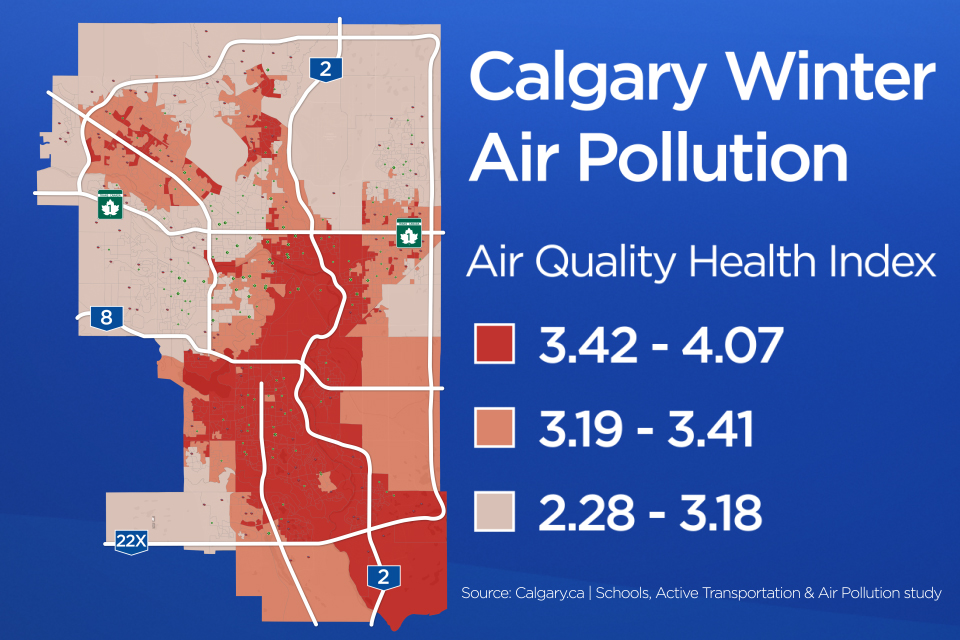Breathe in… breathe out… Is there anything other than the cold, crisp winter air in Calgary making you cough a little?

According to a study from the University of Calgary, if you live south of the Bow River, you’re breathing in the worst air in the city.
The study of seasonal air pollution showed air quality varies significantly throughout the city for reasons researchers can’t really put a finger on.
Calgary was no stranger to air quality advisories this past summer, as smoke from wildfires burning in B.C. and elsewhere drifted into the city.
The study, done by Stefania Bertazzon and Rizwan Shahid of the Georgaphy of Health and GIS Analysis research group at the O’Brien Institute for Public Health in the Cumming School of Medicine, also looked at the potential impacts on school children in neighbourhoods where active transportation, like walking and biking, is popular.
“I’ve done studies on air pollution and every time someone sees the data they say, ‘Oh, wow, the area where I go jogging is in one of the most polluted parts of the city,’” Bertazzon said in a news release.
Using GIS geographic technology, the city’s network of air monitoring stations and data from the city, the researchers were able to capture, manipulate and analyze the datasets and present them using maps.
They created their own air quality health index that read ozone, nitrogen oxide and particulate matter — which are pollutants that can impact human health. High air quality health indexes indicate poor air quality, and vice versa.

The researchers also used ArcGIS software and data from the city to map school neighbourhoods and determined how foot-, cycle- and transit-friendly they are for children by assigning a walk score, bike score and transit score to each one.
What did the researcher find?
Different times of year can have an impact on the amount of air pollution in the city, but it can also have an impact on which areas of the city see high levels of pollutants.
In the summertime, the city’s northeast sees a higher concentration of bad air, according to the research. But it’s the south part of the city that sees some of the highest pollution levels in the winter.
Bertazzon said that finding was a “big surprise.”
“In Calgary, we tend to know the northeast is bad for pollution for a number of reasons, but this shows we cannot assume it’s restricted to that quadrant alone, especially in winter,” she said.
While the two researchers don’t have all the answers as to why this variation exists, they say the data is consistent with seasonal wind patterns: southwest winds in the summer and northern winds in the winter.
Other factors include the city’s multiple main traffic corridors — of which the northeast has several — areas with high concentrations of industrial emitters, prevailing winds and topography.
What are potential risks and actions?
While trying to minimize cars on the road by using things like public transit, cycling or walking to get to work is a healthy alternative to driving solo, the research found those benefits could be reduced if the air quality is low.
“You might be contributing less noxious pollutants, but you’re exposing yourself to those already floating around,” Shahid said.
The negative impacts of air pollution on a young person can affect everything from environmental allergies to breathing issues to a child’s body mass index.
Researchers said at least one study showed that cognitive development was less in children that went to schools in areas with high traffic-related pollution.
While the research shows a problem, Bertazzon said there isn’t a reason to panic, as Calgary’s overall air quality is “pretty good.”
Calgary’s air is better than that of Montreal, Toronto and Edmonton, according to an international comparison published in 2016.
It’s hoped this research will help with the implementation of idle-free strategies in areas like school zones, but Bertazzon and Shahid suggest Calgarians encourage children to walk or bike on pathways away from roadways and not to walk young children near idling school buses.




Comments